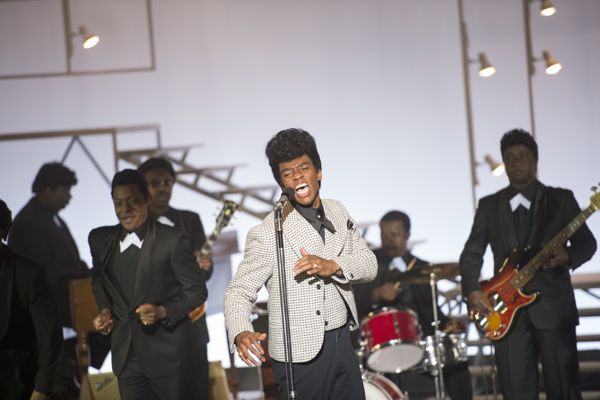
Our love of biopics stems from our unquenchable curiosity about the lead performance—will that actor shed his or her own skin, completely inhabit the part, make us forget that we’re witnessing an impersonation? (Andre 3000 as Jimi Hendrix? Intriguing!)
The stories themselves, however, can be tricky, mostly because their trajectory tends to be the same—picture a line graph ascending straight up, plateauing, dipping down (drug addiction, marital woes, etc.), and then ascending again for our triumphant comeback/conclusion. Of course, one way to avoid that obvious path is to focus on just a tiny chunk of the celebrity’s life, as they did in the great Capote. But that doesn’t always translate—not everyone’s life story is so conveniently excerptable.
Taylor Tate, the director of the rousing new James Brown biopic Get on Up solves the “line graph” problem by jumping back and forth in time. When the film starts, for example, Brown is already the Godfather of Soul, in a track suit and a flamboyant bouffant—and he’s high as a kite. He barges into a seminar of some sort in a building that he owns, wielding a shotgun and demanding to know who had the temerity to relieve themselves in the office bathroom. “Which one of you gentle folks hung a ‘number two’ in my commode?” he demands, hilariously. We keep cutting back and forth: From a trip Brown and his band took to Vietnam to entertain the troops, where they were nearly shot out of the sky (as the band cowers in terror, Brown himself seems singularly unconcerned—nobody would have the audacity to kill Mr. Dynamite) to Brown’s impoverished childhood in Georgia, where he stumbles across a lynched man in the woods and steals his shoes.
We never see that first gold record, or that first single on the radio. Instead, we have Brown hearing Little Richard (Brandon Smith) at a bar—and jumping on stage, unbidden, at intermission. (Later, Little Richard warns Brown against the “white devil”—namely white concert promoters and record companies who seek to exploit black artists.) We have Brown performing on the Ed Sullivan Show, and impressing a young Mick Jagger, who stands agog in the wings. (Jagger actually served as a producer of this film.) We jump back to Brown’s unspeakably awful childhood, where he was abandoned by both his parents and dropped off with an aunt (Octavia Spencer), who runs a brothel. And so on.
This generally works and it gives Brown’s portrayer, Chadwick Boseman, a chance to show off his amazing range as an actor. He doesn’t play Brown as a child—although you half-think he could (those duties go to sad-eyed twins Jamarion and Jordan Scott)—but he ages marvelously (and kudos to the hair and makeup department, who perform minor miracles). In the older scenes, his voice gets more gravelly, his strut loses some of its gusto, his dance moves—while still great—become somewhat less silky smooth. And then, a scene later, he’s back to being young and vital and electrifying.
That being said, the film’s approach does have some drawbacks—namely that it darts around so much, it doesn’t give us the chance to get emotionally invested in the relationships. Brown has two wives, neither of whom we get to know in the slightest (and a scene where he beats his second wife seems tacked on to ameliorate those who might accuse the film of white-washing his life). There is a scene where Brown’s mother (Viola Davis, heartbreaking) comes to visit him backstage—it’s the first time she’s seen him since he was a small boy—and he dismisses her with $100, which she accepts without any demurrals. Again, it’s sad, but fleeting. There’s his relationship with his manager Ben Bart (Dan Aykroyd), including a wonderful scene at a fish fry where he schools Bart on the necessity of eliminating the middle man of concert promoters. But when Bart dies, we don’t care much because Brown doesn’t seem to. (There’s another death in the film, one that should shake us to the core, that barely registers a blip.)
Brown also has a best friend and musical collaborator, Bobby Byrd (Nelsan Ellis), a Solieri of sorts to his funked-out Mozart. Ellis wonderfully plays the burden of being in the service of greatness—he’s a singer, too, and a good one, but he knows that he and James will never be equals. This is the most important relationship in the film—Get on Up closes on a reconciliation between the two men—but I wasn’t especially moved by it. The film suggests that Brown’s talent made him selfish. He had to feed the funk, nothing else mattered.
My biggest complaint with Clint Eastwood’s Jersey Boys, a film I actually liked, was that it didn’t convey the het-up, riotous, primal joy of making music. It was strangely bloodless. Get on Up is the opposite: It pulsates with music and soul and when Boseman is on stage (mostly lip-synching, although he did some original voice work in rehearsal scenes) he’s magnetic, sexy, undeniable. He can dance like Brown—even doing those crazy split moves—and you can really believe that he lives, eats, and breathes the funk.
Boseman gives that command performance we’re all looking for in a biopic. At times, he looks directly at the camera (shades of Kevin Spacey in House of Cards), taking us into his confidence. Sometimes the look says, “Is this guy for real?” as when Ben Bart is blathering on about the protocols of the music industry. When Brown is older, the look is weary, but still defiant (“I’m not dead yet”). But my favorite look comes from young James, one of cocky incredulity, “Can you believe how great I am?” Thanks to the visceral power of Get on Up, we really can.
